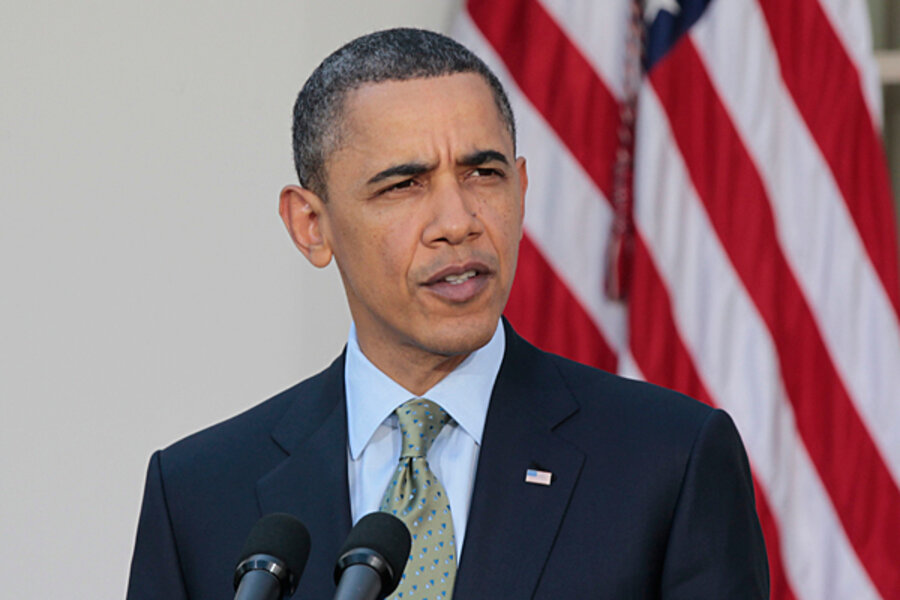Obama seeks to calm US radiation fears, calls for nuclear safety review
Loading...
| Washington
The United States is doing all it can to protect its citizens in Japan and is rushing support to a Japanese government beset by natural disaster and nuclear crisis, President Obama said Thursday.
“We are bringing all available resources to bear to closely monitor the situation and to protect American citizens that may be in harm’s way,” said Obama.
Obama also said that he had asked for a comprehensive review of US nuclear plant safety in light of Japanese events. In particular, he’s requested that the Nuclear Regulatory Commission study whether US reactors could withstand once-in-a-lifetime natural events such as the earthquake and tsunami that turned much of Japan’s Fukushima I nuclear complex into a dangerous ruin.
Japan nuclear crisis: Nuclear terminology 101
“Our nuclear power plants have undergone exhaustive study and have been declared safe for any number of extreme contingencies. But when we see a crisis like the one in Japan, we have a responsibility to learn from this event and to draw from those lessons to ensure the safety and security of our people,” Obama said.
The president’s Rose Garden appearance – on a brilliant spring-like day in Washington – came at a time when the US and Japanese governments have issued different warnings as to how far from the Fukushima plant it is safe to be. A lack of status updates from Japan itself may have further added to a sense of confusion about what’s going on.
Thus Obama may have taken a moment to perform one of a president’s primary duties: serve as a voice of calm at a time when some US citizens might be anxious.
Fears that a radioactive plume might drift to the continental US have caused a run on potassium iodide pills, for example, which can offset some health effects of radiation. Obama stressed Thursday that the worry driving those purchases is unfounded.
“We do not expect harmful levels of radiation to reach the West Coast, Hawaii, Alaska, or US territories in the Pacific,” he said.
Obama’s appearance capped a day in which top officials fanned out across Washington to make public statements about the US effort in Japan.
At the State Department, officials noted that the first evacuation flight of US citizens from Japan had already left.
The flight had fewer than one hundred people on it, mostly dependents of US diplomats, said Under Secretary of State for Management Patrick Kennedy.
“The flight did not leave full,” he said.
The State Department will mount another flight in a day or so if demand warrants, he said. In addition, the US has dispatched a convoy of 14 buses to the area of northeastern Japan slammed by the earthquake and tsunami to try and evacuate US citizens who lack transport to Tokyo.
Wider zone around plant is 'prudent'
At a separate White House briefing, Nuclear Regulatory Commission head Gregory Jaczko said that the US recommendation of a 50-mile exclusion zone around the Fukushima plant remained “prudent” in light of continuing developments. He declined to directly criticize the Japanese government for recommending a smaller zone.
“I would stress that this is a very difficult situation. There’s often conflicting information,” Mr. Jaczko said. On Wednesday Jaczko testified before a congressional subcommittee that radiation levels at the stricken plant remained very high, and that the water in a spent fuel pool at the No. 4 reactor had run dry, contradicting statements by Japanese officials.
The NRC has 11 technical experts in Tokyo working with the Japanese government, Jaczko said Thursday. Deputy Secretary of Energy Dan Poneman said his department has dispatched a US Air Force C-17 airlifter with 33 additional experts and 17,000 pounds of equipment.
The Department of Energy has in place in Japan two aircraft-mounted pods that measure the amount of radioactive material that has fallen to the ground, said Mr. Poneman. Those pods, one on a helicopter and one on a fixed-wing aircraft, have already begun making flights.
US collecting own data
So in terms of the US gathering data about what is going on, “It’s not just people talking to people,” Poneman said, alluding to the fact that the US is not depending solely on Japanese officials for data.
NRC chief Jaczko said that given the struggle of the Japanese to bring cooling systems at Fukushima under control it now appears it could be weeks before the crisis eases.
“And that’s why, as I said, we’re continuing to do everything we can to provide assistance to the Japanese as they deal with this situation,” he said.





